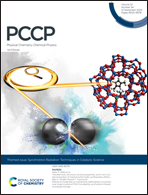Charge pattern affects the structure and dynamics of polyampholyte condensates†
Abstract
Proteins with intrinsically disordered regions have a tendency to condensate via liquid–liquid phase separation both in vitro and in vivo. Such biomolecular coacervates play various significant roles in biologically important regulatory processes. The present work explores the structural and dynamic features of coacervates formed by model polyampholytes, being intrinsically disordered proteins, that differ in terms of their charged amino acid patterns. Differences in the distribution of charged amino acids along the polyampholyte sequence lead to distinctly different structural features in the dense phase and hence to different liquid properties. Increased charge clustering raises the critical temperature for phase separation and results in each polyampholyte experiencing a larger number of inter-chain contacts with neighboring proteins in the condensate. Consequently, polyampholytes with greater charge clustering adopt a much more extended conformation, having a radius of gyration up to twice that observed in the dilute bulk phase. Translational diffusion within the droplet is pronounced, being just 4–20 times slower than in the bulk, consistently with the high conformational entropy in the dense phase and high exchange rate of the network of intermolecular interactions in the condensate. Coupled to the faster diffusion, the condensate also adopts a more elongated shape and exhibits imperfect packing, which results in cavities. This study quantifies the fundamental microscopic properties of condensates including the effect of long-range electrostatic forces and particularly how they can be modulated by the charge pattern.



 Please wait while we load your content...
Please wait while we load your content...